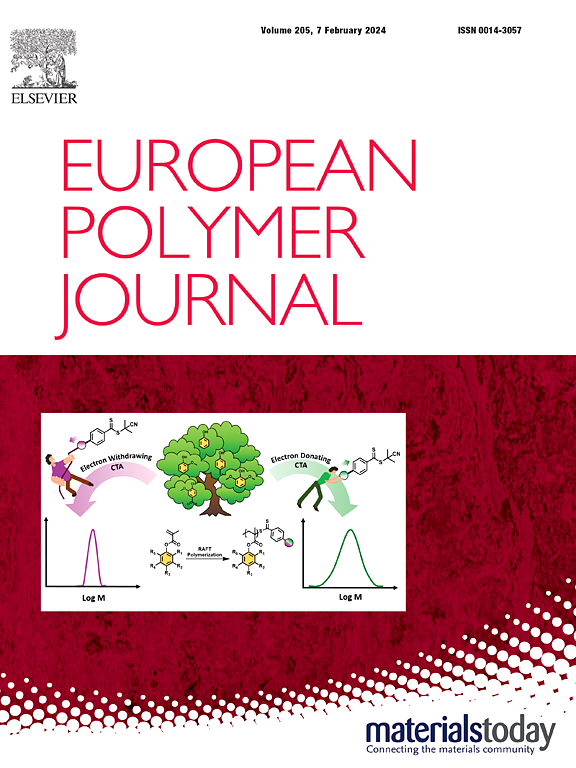Thermogelling Formulations based on In-House synthesized ethylene Glycol-Containing ABC triblock copolymers and their mixtures with diblocks
IF 5.8
2区 化学
Q1 POLYMER SCIENCE
引用次数: 0
Abstract
This study investigated the thermoresponsive properties of a novel series of ABC triblock terpolymers synthesized from ethylene glycol (EG)-based comonomers with varying lengths of PEG pendant chains. The terpolymers, with a targeted molar mass of 8100 g/mol, were synthesized using sequential Group Transfer Polymerization (GTP) and featured a range of compositions. Specifically, the hydrophobic content of methoxy ethylene glycol methacrylate (MEGMA, block B) was varied between 25 % and 55 % w/w, with corresponding adjustments to the thermoresponsive oligo(ethylene glycol) methyl ether methacrylate (OEGMA with an average molar mass of 300 g/mol, block A) and di(ethylene glycol) methyl ether methacrylate (DEGMA, block C), resulting in 16 distinct compositions. The cloud point temperatures were determined via turbidimetry, while dynamic light scattering (DLS) was employed to assess micellar self-assembly behavior. Of the 16 terpolymers, three demonstrated the ability to form thermogels. Blending these terpolymers with a high-performing diblock copolymer enabled tunable sol-to-gel transitions and identified a specific concentration that facilitated thermogel formation at physiological temperatures. Notably, the M1 polymer solution—a mixture of a triblock terpolymer and its diblock counterpart, both with 50 % w/w MEGMA content—exhibited superior sustained release of the sodium fluorescein model drug, outperforming the industry-standard Pluronic F127. This study underscores the importance of balancing hydrophilicity and hydrophobicity for effective sol–gel transitions in these novel triblock terpolymers and presents a straightforward yet effective strategy for diversifying polymer mixtures to fine-tune the gelation range and enhance versatility.

求助全文
约1分钟内获得全文
求助全文
来源期刊

European Polymer Journal
化学-高分子科学
CiteScore
9.90
自引率
10.00%
发文量
691
审稿时长
23 days
期刊介绍:
European Polymer Journal is dedicated to publishing work on fundamental and applied polymer chemistry and macromolecular materials. The journal covers all aspects of polymer synthesis, including polymerization mechanisms and chemical functional transformations, with a focus on novel polymers and the relationships between molecular structure and polymer properties. In addition, we welcome submissions on bio-based or renewable polymers, stimuli-responsive systems and polymer bio-hybrids. European Polymer Journal also publishes research on the biomedical application of polymers, including drug delivery and regenerative medicine. The main scope is covered but not limited to the following core research areas:
Polymer synthesis and functionalization
• Novel synthetic routes for polymerization, functional modification, controlled/living polymerization and precision polymers.
Stimuli-responsive polymers
• Including shape memory and self-healing polymers.
Supramolecular polymers and self-assembly
• Molecular recognition and higher order polymer structures.
Renewable and sustainable polymers
• Bio-based, biodegradable and anti-microbial polymers and polymeric bio-nanocomposites.
Polymers at interfaces and surfaces
• Chemistry and engineering of surfaces with biological relevance, including patterning, antifouling polymers and polymers for membrane applications.
Biomedical applications and nanomedicine
• Polymers for regenerative medicine, drug delivery molecular release and gene therapy
The scope of European Polymer Journal no longer includes Polymer Physics.
 求助内容:
求助内容: 应助结果提醒方式:
应助结果提醒方式:


